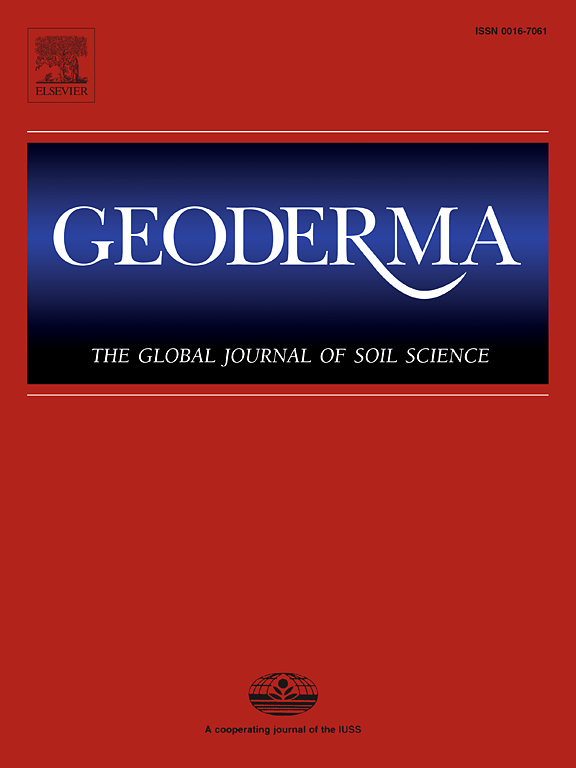Effects of slope shape on soil erosion and deposition patterns based on SfM-UAV photogrammetry
IF 6.6
1区 农林科学
Q1 SOIL SCIENCE
引用次数: 0
Abstract
Slope shape as a consequence of erosional landform development plays a prominent role in soil erosion. Clarifying the distribution of soil erosion and deposition patterns on different shaped slopes is crucial for soil erosion control. The aim of this study was to decipher the effects of slope shape on soil erosion and deposition patterns under natural rainfall conditions based on high-resolution unmanned aerial vehicle (UAV) data and geographic information system technology. Structure from motion (SfM)-UAV photogrammetry was carried out in four runoff plots with various slope shapes during the rainy season in 2021. Digital elevation models (DEMs) were developed for each slope shape before and after the rainy season. In addition to collecting runoff and sediment, the DEMs of difference were analyzed to quantify soil erosion and deposition patterns on various slope shapes in the rainy season. Results showed that the runoff volumes and sediment yields induced by rainfall were markedly different among various slope shapes. The mean runoff volume and sediment yield from the concave-convex slope were 1.09 ∼ 2.69 and 1.33 ∼ 27.16 times those of the other three slopes, respectively, with less sediment loss from the convex-concave slope and its combination slope. Slope shape exhibited a notable effect on the type of slope erosion and deposition. All four slopes showed considerable changes in surface elevation after the rainy season. The increase and decrease in surface elevation were concentrated in the range of –0.02 to –0.007 m and 0.007 to 0.02 m, respectively, with a low proportion of changes less than –0.03 m and greater than 0.03 m. The effectiveness of SfM-UAV in monitoring the microgeomorphic changes of slopes was verified by the consistency of soil erosion amounts based on sediment collection and SfM-UAV measurements. Reference values were provided to solve the threshold problem of slope length cutoff in soil erosion prediction models based on runoff plot experiments. Findings of this study could be useful for decision-making in soil erosion control and slope reconstruction.
基于 SfM-UAV 摄影测量的斜坡形状对土壤侵蚀和沉积模式的影响
坡形是侵蚀地貌发展的结果,在土壤侵蚀中起着重要作用。明确不同坡形的土壤侵蚀和沉积分布模式对于控制土壤侵蚀至关重要。本研究旨在基于高分辨率无人机(UAV)数据和地理信息系统技术,解读自然降雨条件下坡形对土壤侵蚀和沉积模式的影响。在 2021 年雨季期间,对四个具有不同坡形的径流地块进行了运动结构(SfM)-无人机摄影测量。在雨季前和雨季后,为每种坡形建立了数字高程模型(DEM)。除了收集径流和沉积物外,还对差异 DEM 进行了分析,以量化雨季中不同坡形的土壤侵蚀和沉积模式。结果表明,降雨引起的径流量和泥沙量在不同坡形之间存在明显差异。凹凸斜坡的平均径流量和泥沙量分别是其他三种斜坡的 1.09 ∼ 2.69 倍和 1.33 ∼ 27.16 倍,凸凹斜坡及其组合斜坡的泥沙流失量较少。斜坡形状对斜坡侵蚀和沉积类型有显著影响。雨季过后,四个斜坡的表面高程都发生了很大变化。根据沉积物采集和 SfM-UAV 测量结果得出的土壤侵蚀量的一致性验证了 SfM-UAV 监测边坡微地貌变化的有效性。该研究为解决基于径流小区实验的土壤侵蚀预测模型中的坡长截断阈值问题提供了参考值。本研究的结果可用于水土流失控制和边坡重建的决策。
本文章由计算机程序翻译,如有差异,请以英文原文为准。
求助全文
约1分钟内获得全文
求助全文
来源期刊

Geoderma
农林科学-土壤科学
CiteScore
11.80
自引率
6.60%
发文量
597
审稿时长
58 days
期刊介绍:
Geoderma - the global journal of soil science - welcomes authors, readers and soil research from all parts of the world, encourages worldwide soil studies, and embraces all aspects of soil science and its associated pedagogy. The journal particularly welcomes interdisciplinary work focusing on dynamic soil processes and functions across space and time.
 求助内容:
求助内容: 应助结果提醒方式:
应助结果提醒方式:


